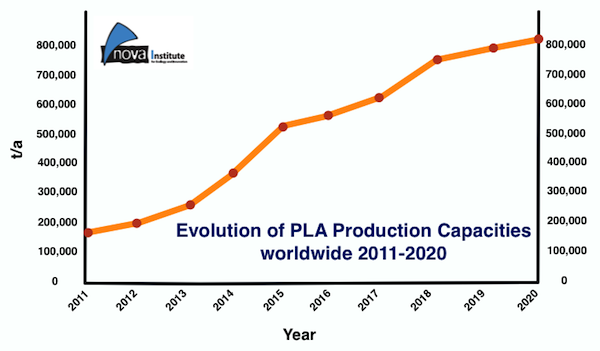25 companies have developed production capacity at 30 sites worldwide of over 180,000 t of polylactic acid (PLA), one of the leading bio-based plastics. PLA is used mainly in packaging, but it also has a large number of other durable applications. The largest producer is NatureWorks, a company that is active in the USA and Thailand, and has a capacity of 140,000 t/year. The other producers have a current capacity of between 1,500 and 10,000 t/year.
According to their own forecasts, existing PLA producers are planning considerable expansion of their capacity to around 800,000 t/year by 2020 (cf. above figure). There should be at least 7 sites with a capacity of over 50,000 t/year by then. A survey of lactic acid producers – the preliminary stage of PLA production – revealed that production capacity to meet concrete requests from customers that cannot yet be named could even rise to roughly 950,000 t/year.

Michael Carus, managing director of nova-Institute in Hürth (Germany) reacted thus to the survey results: “For the very first time we have robust market data about worldwide PLA production capacity. These are considerably higher than in previous studies, which did not cover all producers. Forecasts of 800,000 or even 950,000 t/year by 2020 show that PLA is definitely a polymer for the future.”
The results are derived from the most comprehensive international market survey of bioplastics to date, which was carried out in conjunction with renowned international plastics experts. The “Market Study on Bio-based Polymers and Plastics in the World” will be published in January 2013 and contains, along with a 300-page report, access to the newly developed “Bioplastics Producer Database”. It s the methodology of this market survey that is so special, since it provides a comprehensive study of every producer of over 30 different bioplastics around the world. The data covering the capacity, production, uses and raw materials was collected through over 100 interviews with senior and top-level managers as well as questionnaires and a literature review. Alongside this market data, the report will contain analysis of future trends by renowned experts Jan Ravenstijn (bioplastics consultant, The Netherlands), Wolfgang Baltus (National Innovation Agency (NIA), Thailand), Dirk Carrez (Clever Consult, Belgium), Harald Käb (narocon, Germany) and Michael Carus (nova-Institute, Germany). The report and database access will be available from nova-Institute for €6,500 net from January.
Summer promotion
If you order before the end of September, the report and access to the “Bioplastics Producer Database” are available at the special price of €5,500 net, saving you €1,000 on the price after this date.
Coordinated by nova-Institute, the multi-client survey has already been funded by more than 20 renowned companies and institutions, which have also overseen the project as part of the Advisory Board. Additional partners are more than welcome. For €6,000 they receive not only the report and access to the “Bioplastics Producer Database” but can also sit on the Advisory Board. You can find in-depth information about the survey programme and the partnership agreement as well as the producer questionnaire at www.bio-based.eu/market_study
Bioplastics producers that submit a completed questionnaire will not only be findable by potential new business partners via the “Bioplastics Producer Database” but will also receive free online access for a limited period of time.
Figure available for download at: www.nova-institut.de/bio/data/images/pla.png
Download this press release as PDF file: 12-08-06_pr_market_study_bioplastics_nova
Source
nova-Institut GmbH, press release, 2012-08-07.
Supplier
Clever Consult
narocon
National Innovation Agency (NIA)
nova-Institut GmbH
Share
Renewable Carbon News – Daily Newsletter
Subscribe to our daily email newsletter – the world's leading newsletter on renewable materials and chemicals










